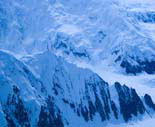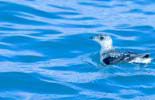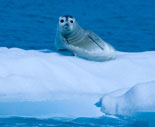 |
 |
 |
| Camp Pendleton | ||||||||
|
||||||||
 |
||||||||
 |
||||||||
 |
||||||||
Wrangell-St. Elias National Park and Reserve
DSF chose to highlight Wrangell-St.Elias National Park and Preserve for its Sanctuary book for several reasons. One, it is the largest park in the United States. And, in combination with the contiguous preserves and parks in Canada, it forms the largest terrestrially protected area in all of North America, and one of the most extensive on the planet. It contains the largest number of glaciers in North America, many unnamed; and its tidewater glaciers (glaciers flowing directly into the Gulf of Alaska) are unique ecosystems in and of themselves.
18% of the entire known global population of Kittlitz's Murrelets, one of the most endangered seabirds in the United States, lives in a particular Bay at the base of the largest vertical mountain wall on Earth, the West Face of Mount St. Elias (over 18,000 feet in elevation), the third largest peak in North America, after Mount McKinley and Canada's Mount Logan. Mount St. Elias rises above the waters of the Pacific and its sheer walls and glacial shelves are home to this tenacious, remarkable little Alcidae family avian, the solitary Murrelet. The bird nests on the cliffs, possibly directly on the glaciers, but feeds socially out at sea.
Biologist Michelle Kissling and team, with the U.S. Fish & Wildlife Service, as well as the National Park Service, have a long term study in place to better estimate the numbers of individual murrelets, their diet, distribution, movements throughout the year, reproductive ecology and behavior. The goal is to try and gain sufficient knowledge in order to help these birds stave off rapid decline. Sadly, their numbers have decreased some 80% in the past decade and a half. They'll be gone in two decades if their crisis cannot be thoroughly identified and any adverse conditions somehow mitigated.
The extinction factors affecting this and other seabirds have previously been thought of largely in terms of potential oil spills, but there are countless other considerations.
Global Warming looms large, a reality that may make it all but impossible for humans to restore healthy Kittlitz's populations. No one knows for sure, because neither the Aleutians nor the Lost Coast of Alaska have yet been surveyed for this species. DSF has committed to assisting with the ongoing research effort by the U.S. Fish & Wildlife and National Park Service. DSF's grant in support of Kissling's research team effort has resulted in their obtaining matching funds from the Park Service and from the Wildlife Conservation Society.
PDF FILE: of Michelle Kissling's Research
Kittlitz’s Murrelet Cooperative Study in Icy Bay, Alaska
Saint Elias National Park and Preserve, Alaska
Michelle Kissling, U.S.Fish & Wildlife/Juneau, Alaska
http://www.fws.gov/

